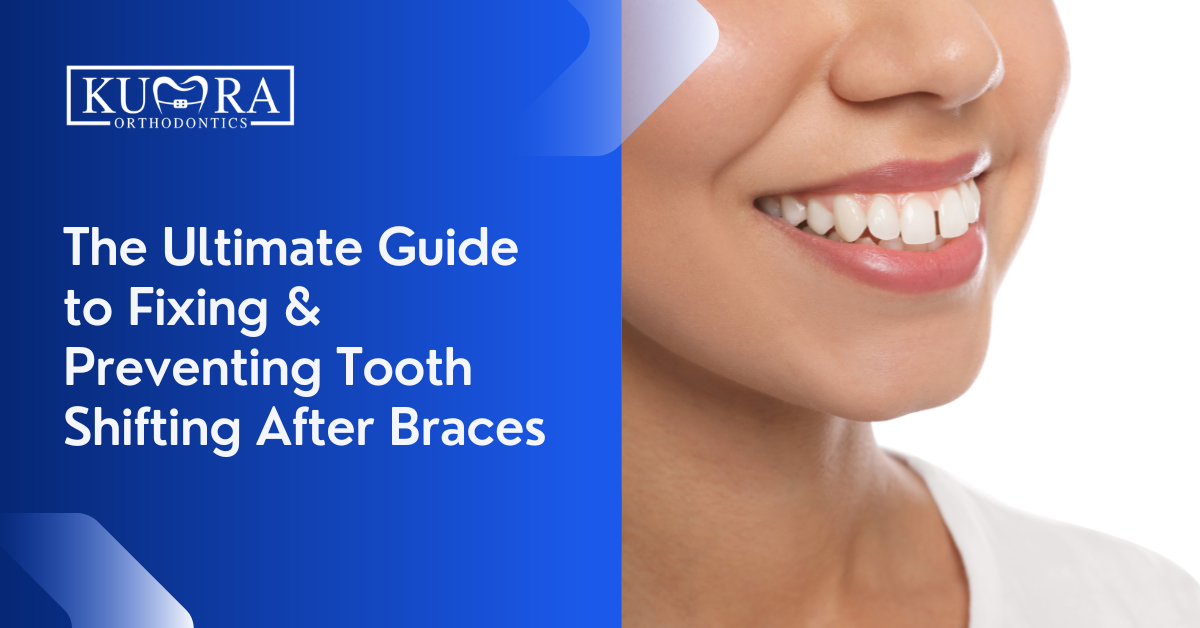It’s a moment of panic every orthodontic patient dreads: you look in the mirror one day and notice a change. A small gap, a slight rotation, a feeling that your teeth are shifting after braces. After all the time, investment, and dedication, seeing that perfect smile begin to fade is incredibly frustrating and stressful. You’re not just looking for answers; you’re looking for reassurance and a clear plan of action.
First, Take a Breath. It’s More Common Than You Think (And It’s Fixable).
Before we go any further, know this: you haven’t failed, and you are not alone. A minor degree of tooth movement after orthodontic treatment is a natural biological process. The key is to understand why it’s happening and to act promptly to protect your investment.
As the team at Kumra Orthodontics, we want to provide the clarity and solutions you need. Our first piece of advice is always the same: don’t panic. We have clear, effective solutions to address post-braces shifting and get your smile back on track. This guide will walk you through why this happens, what to do right now, and how we can help.
The “Why” Behind the Shift: A Look at Your Teeth’s ‘Muscle Memory’
To understand why your teeth want to move, think of the structures holding them in place like a set of invisible “elastic bands.” These are your periodontal ligaments (PDLs). During your time in braces, these ligaments were stretched as your teeth were guided into their new positions. Your jawbone also went through a process of “remodeling clay,” where old bone was broken down and new bone was built up to support the new alignment.
When your braces come off, those stretched ligaments have a natural tendency to want to pull back to their original positions. This process is known as orthodontic relapse. Your retainer is the only thing holding them in their corrected place while the bone fully solidifies, a process that can take many months. Without consistent retainer use, that muscle memory kicks in and your teeth will begin to shift.
The Relapse Severity Scale: How Much Shifting is Too Much?
It can be hard to know if what you’re seeing is a minor adjustment or a major problem. We developed this simple framework to help you self-assess your situation and understand when it’s time to call a professional.
- Minor Shift (Green Zone): You might notice a very tiny change that no one else can see. Your retainer might feel a little snug or tight when you put it in, but it still fits without causing pain.
- Moderate Shift (Yellow Zone): The change is now more visible, perhaps a small gap has reappeared or a tooth has slightly rotated. Your retainer no longer fits properly, or you can’t get it to seat all the way down on your teeth. You might also notice a slight change in your bite. If you are in the Yellow Zone, an immediate consultation is recommended to prevent further shifting.
- Significant Shift (Red Zone): There is an obvious and noticeable return of the crowding or spacing issues you had before braces. Your bite feels “off,” and you may even experience some jaw pain. Your old retainer doesn’t fit at all. For a shift of this magnitude, a professional assessment is crucial.
The Usual Suspects: Top 5 Reasons Your Teeth Are Shifting
While retainer non-compliance is the number one cause, several other factors can contribute to orthodontic relapse.
The Retainer Relationship (It’s Complicated)
This is the most common reason for teeth shifting. Whether you’ve lost your retainer, it’s broken, or you’ve simply fallen out of the habit of wearing it, inconsistency is the main culprit. There are different types of retainers, from clear Essix retainers to fixed (permanent) ones bonded to your teeth, and each has its own care requirements. One of the top-ranking guides notes that proper retainer care is essential for preventing relapse. [https://fredericksburgorthodontics.com]
From the Doctor’s Chair: “If your retainer is lost or broken, don’t wait. Call your orthodontist immediately. A few days without a retainer can be enough for noticeable shifting to begin.”
The Daily Grind (Bruxism)
Many people grind or clench their teeth (a condition called bruxism), often while they sleep. This constant, powerful force can overwhelm your retainer and gradually move your teeth out of alignment.
From the Doctor’s Chair: “If you wake up with a sore jaw, a dull headache, or worn-down teeth, you might be grinding at night. A custom nightguard can protect your teeth and your orthodontic results.”
The March of Time (Natural Aging)
Just as our bodies change over time, so do our faces and jaws. As we age, there’s a natural tendency for the lower jaw to narrow slightly, which can cause the bottom teeth to become more crowded. This is a slow, gradual process, but it underscores the importance of lifetime retainer wear.
Gum Health is Smile Health
Your gums and the underlying bone are the foundation that holds your teeth in place. Gum disease (periodontitis) weakens this support structure, making your teeth more susceptible to shifting. Premier Orthodontics explains that gum disease is a significant contributor to unwanted tooth movement. [https://premierorthodontics.com]
Tongue Thrust & Oral Habits
The way you swallow and the resting position of your tongue can exert gentle but constant pressure on your teeth. A “tongue thrust,” where the tongue pushes against the front teeth during swallowing, can be a powerful force that leads to an open bite or flared teeth over time.
Your Action Plan: What to Do RIGHT NOW
Feeling empowered comes from having a clear, step-by-step plan. Move from passive reading to active problem-solving with these immediate steps.
Step 1: Find Your Last Retainer (And Try It On… Gently)
The very first thing you should do is find your most recent retainer. Rinse it and try to put it in.
- If it’s a little tight: It might still work. Wear it full-time for a few days to see if the teeth gently guide back into place. Do not force it.
- If it causes pain or doesn’t seat fully: STOP. Forcing a retainer that no longer fits can damage your teeth. This is a clear sign you need to see your orthodontist.
Step 2: The 2-Week Rule & Timeline of Shifting
Urgency is key. In the first few weeks and months after braces are removed, shifting can happen rapidly. After that, it may slow down, but it continues. As a general rule, if you haven’t worn your retainer for more than two weeks, it’s very unlikely to fit properly, and it’s time to call a professional.
Step 3: Your Relapse Correction Options at Kumra Orthodontics
This is the hard sell, framed as helpful solutions. The good news is that correcting a relapse is almost always faster and less involved than your original treatment. Here are the primary options we use to help our patients.
For Minor Shifts: A New Retainer or Retainer Adjustments
If the shifting is minimal and caught early, the solution can be as simple as making a new, perfectly fitting retainer. This new retainer will capture the teeth in their current position and prevent any further shifting.
For Moderate Shifts: Invisalign Express
For more noticeable gaps or rotations, a “touch-up” treatment is often the perfect solution. Invisalign Express uses a series of clear, removable aligners to efficiently guide teeth back to their ideal positions. It’s a discreet, fast, and effective way to correct a moderate relapse, often in just a few months.
For Significant Shifts: A Short-Term Braces Treatment
Even for a significant relapse, you likely won’t need to go through the full braces experience again. We can use a targeted, short-term braces treatment that focuses only on the specific teeth that have moved. This is often faster and more comfortable than your original orthodontic work.
The “Am I a Candidate for Re-Treatment?” Checklist
If you’re still unsure, run through this quick checklist. It can help you self-qualify and decide if it’s time for a professional assessment.
- Does your retainer no longer fit or cause you pain?
- Have you noticed a new gap or crooked tooth when you smile?
- Do you find yourself avoiding smiling in photos because of the changes?
- Has it been more than a month since you consistently wore your retainer?
- Does your bite feel ‘off’ when you chew?
If you checked two or more of these boxes, it’s time for a professional assessment. Your smile is worth it.
Your Forever Smile: How We Partner With You to Prevent Future Shifting
At Kumra Ortho, treatment doesn’t end when the braces come off. We believe in building a long-term partnership to protect your investment for decades to come. We create a personalized retention plan for every patient, emphasizing that lifetime retainer wear is the gold standard for preventing future shifting. Regular check-ups allow us to monitor your stability and make proactive adjustments before a minor issue becomes a major one. This reinforces our brand promise of high-quality, long-term care.
Take the Next Step with Confidence
Reading this guide is the first step toward taking back control of your smile. You understand the why, the what, and the how of post-braces relapse. The next step is to get a professional, empathetic assessment from an expert who can tailor a solution just for you.
Don’t let worry or frustration hold you back any longer. At Kumra Orthodontics, we turn panic into a plan. Schedule your complimentary relapse assessment with our experienced team in Washington, DC, or Stafford, VA. We will evaluate your unique situation, listen to your concerns, and provide clear, transparent options to restore your beautiful smile.





